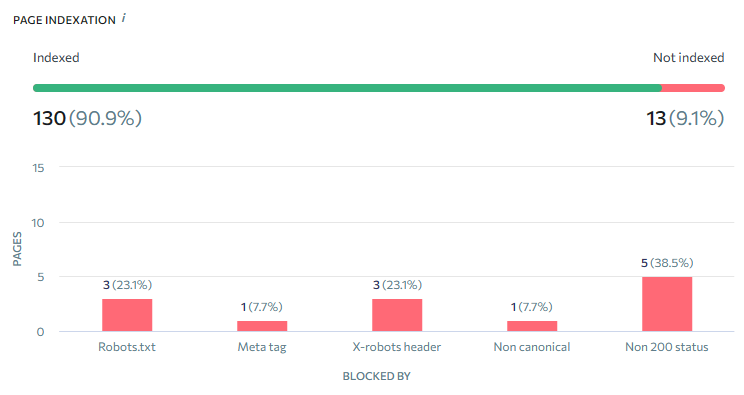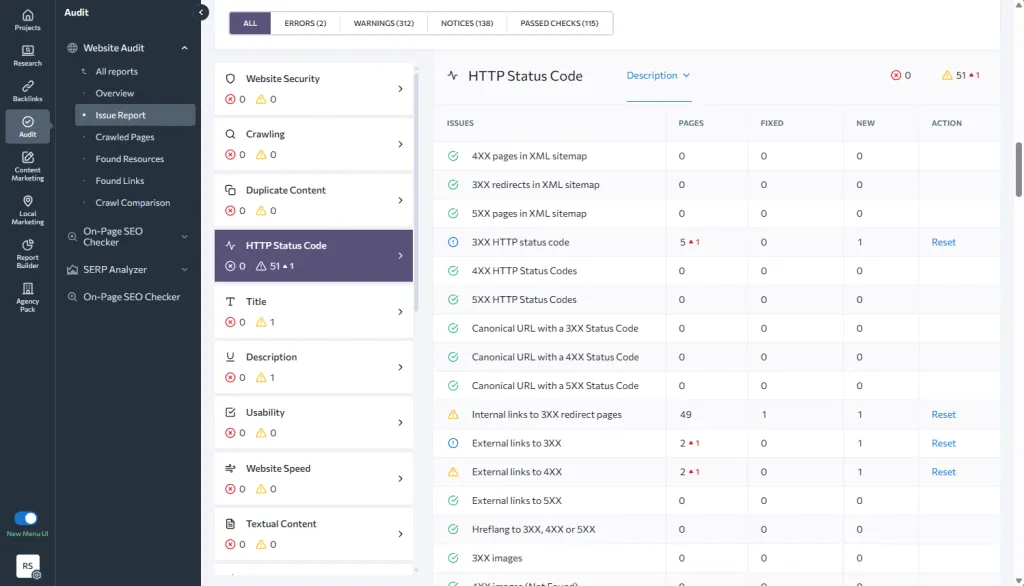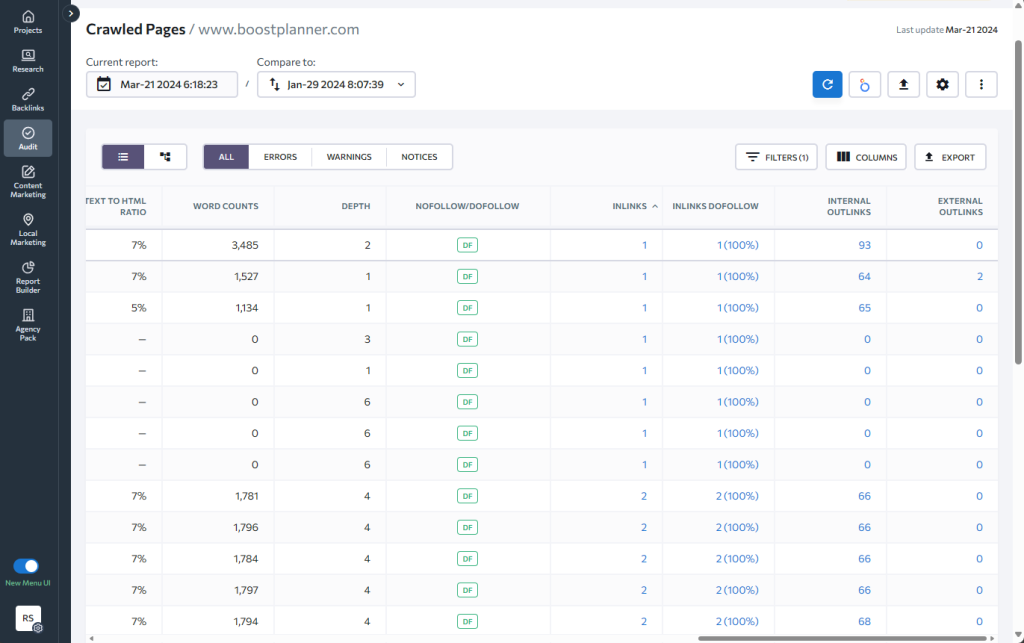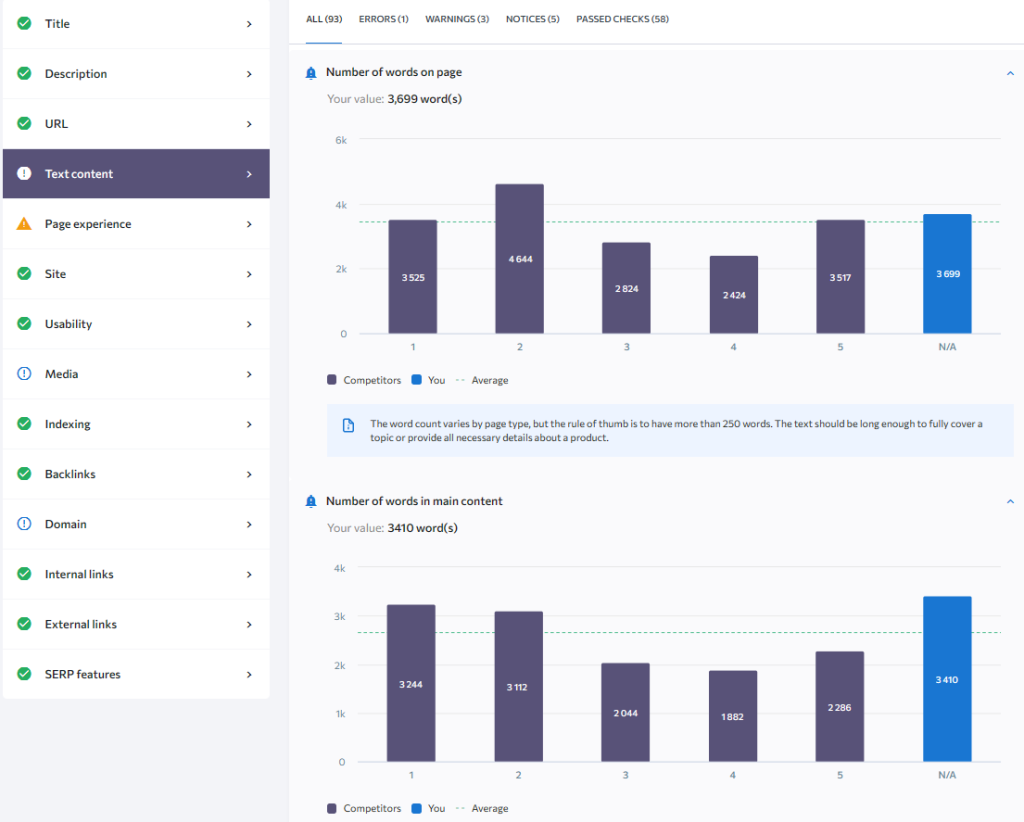Diving into the world of SEO, a website health check is your first step towards a stellar online presence.
This practical guide will walk you through a comprehensive SEO audit, focusing on the key factors that determine your website's performance and visibility in search results.
We’ll explore essential checks and fixes to keep your site in top SEO shape and ensure it’s primed for peak performance.
While I use SE Ranking for auditing site health, there are other great SEO audit tools on the market with sitewide and on-page features you can use for an in-depth analysis.
Sitewide SEO Audit
A sitewide SEO audit is a comprehensive approach to uncovering the larger issues that might be affecting your entire website. It's the first step in ensuring every page on your site contributes to a strong SEO foundation.
Check Top Issues
When conducting an SEO audit, it's crucial to pinpoint the primary concerns that could be hindering your website's performance. Our review starts by identifying the most common issues that need your attention:

No Inbound Links: Pages without inbound links are like isolated islands; they’re hard for search engines and users to find. Adding quality inbound links can increase visibility and credibility.
Nofollow Internal Links: These links do not pass ‘link juice' and can limit the flow of authority through your site. It’s important to use them carefully.
Minimum Text to HTML Ratio: A low text-to-HTML ratio suggests that a page may have more code than content, which can slow down loading times and keyword relevance.
Internal Links to 3XX Redirect Pages: Linking to pages with redirects can waste crawl budget and create unnecessary complexity. Ensuring direct links to the final content is best practice.
One Inbound Internal Link: Pages with only a single internal link may be undervalued by search engines. Increasing internal links can improve navigation and distribute page authority more evenly.
Each issue's impact varies, but collectively they provide a snapshot of your site’s SEO health. The image above provides a visual breakdown of these problems, helping you to prioritize which issues to tackle first for the greatest impact on your site’s performance.
Check Page Indexation
Ensuring your pages are indexed is like opening the doors of your digital storefront to the world. It's a fundamental step to appear in search results and attract traffic. Let's break down the potential indexing status of pages:

Robots.txt: The robots.txt file is a gatekeeper, telling search engines which pages to visit and which to ignore. If pages are blocked here, they are hidden from search.
Meta Tag: Specific meta tags can prevent a page from being indexed. It's crucial to review your meta tags to ensure they aren't unintentionally blocking search engines.
X-robots Header: Similar to meta tags, this HTTP header can restrict search engine access. Ensure that your server responses do not contain directives that keep pages out of search results.
Non-canonical: Pages marked as non-canonical are often overlooked by search engines in favor of the designated canonical page, so double-check these settings to confirm they're correct.
Non 200 Status: Pages that don’t return a successful HTTP status code (200) are not indexed. Pages with errors (like 404 not found or 500 server error) need to be fixed to regain their index status.
Addressing these barriers is a key step towards improving your site’s SEO. By diagnosing and mending the issues that prevent indexing, you can enhance your site's visibility and ensure that all your content has the chance to rank.
Check for Broken Links
Broken links are more than just a dead end for your users; they can significantly disrupt the user experience and diminish the credibility of your site. It's essential to routinely scan for and fix broken links. Here's what you should look out for:

3XX HTTP Status Code: Redirects are not inherently bad, but they should be used correctly. Ensure that 301 redirects point to relevant pages, and avoid chains of redirects.
4XX HTTP Status Codes: These indicate that a link is broken, leading to a page that can't be found. This error needs immediate attention as it affects both users and search engine crawlers.
5XX HTTP Status Codes: Server errors represented by these codes suggest bigger issues that may require a technical review of your server's health.
External Links to 3XX/4XX: Just like internal links, external links leading to redirects or non-existent pages should be corrected to maintain link value and user trust.
Internal Links to 3XX Redirect Pages: While it's good to update or consolidate content, make sure that internal redirects are not excessive, as they can dilute link equity and slow down crawlers.
The accompanying image visualizes these issues and helps you quickly identify where action is needed. Addressing these concerns not only improves the navigation of your site but also solidifies your website’s standing with search engines.
Check Inlinks & Outlinks
The network of links within and outside your website forms the foundation of a good SEO strategy. It's crucial to analyze both inlinks (internal links) and outlinks (external links) for a well-rounded site structure. Here's how to assess your site’s link network:

Text to HTML Ratio: A balanced text to HTML ratio ensures content richness. Low text content could signal an overly complex code structure that dilutes the content's impact.
Dofollow Links: Dofollow links are essential for SEO as they pass on link equity. Verify that important internal links are marked as ‘dofollow' to strengthen your internal pages.
Inlinks Count: Each page should have multiple internal links. Pages with only one inlink may be seen as less important by search engines.
Internal Outlinks: A reasonable number of internal outlinks helps distribute link equity and assists users and crawlers in navigating your website.
External Outlinks: While less critical than internal links, it's still important to ensure that any external links are relevant, trustworthy, and add value for your users.
The image above provides a visual guide to the link architecture of your website. By optimizing both inlinks and outlinks, you reinforce your site’s structure, enhance user experience, and can boost your SEO rankings.
Check Sitewide Textual Content
Content is a fundamental aspect of SEO, and its quality across your website must be monitored for optimization. Here’s what to scrutinize in your sitewide textual content:

Consistent Use of Headers: Check for missing H1 tags or pages with multiple H1s. Each page should have a single, clear H1 tag that accurately reflects the content.
Title and Header Alignment: Ensure your titles and H1 tags are not identical; they should complement each other and guide the reader effectively.
Hierarchical Structure: Look for missing H2 tags. Proper use of H2s and subsequent headers can organize content and enhance readability.
Content Length: Monitor pages with a low word count. Substantial, meaningful content tends to perform better in search rankings.
Duplicate Content: Avoid having duplicate H1 tags or titles across different pages. Unique and descriptive titles and headers help search engines understand and rank pages separately.
The image above gives a snapshot of these textual elements. It's important to regularly review and refine your site's content for clarity, structure, and SEO effectiveness, ensuring each page contributes positively to your overall search engine ranking.
Check Site Resources
Your website's resources—images, CSS, and JavaScript—play a vital role in performance and user experience. Here’s how to ensure they're fully optimized:

The image shares the types and statuses of resources on your site.
Image Optimization: Check the size of your images. Large files can slow down page loading times, so consider compressing them without losing quality.
CSS and JavaScript Minification: Minimize these files to reduce load time. Clean, compact code can significantly speed up your website.
Resource Loading Time: Evaluate the loading time of each resource. Aim for fast-loading pages to improve user experience and SEO ranking.
Correct Resource Status: Ensure all resources load correctly with a 200 HTTP status code. This indicates that the resources are found and accessible.
Update and Remove Unused Resources: Regularly review your site's resources and remove any that are outdated or no longer used to declutter your site's codebase.
By keeping these elements streamlined and efficient, you'll maintain a speedy, smooth-running website that satisfies both visitors and search engines.
Other Factors to Check
An effective SEO audit goes beyond content and links to consider a broader range of factors. Here are several other elements to evaluate:

Page Depth: Examine the number of clicks required to reach a page from the homepage. Pages deeper within the site may receive less attention from search engines and visitors.
Server Response Time: Fast server responses are critical for a swift site experience. Aim for the lowest server response time possible to boost SEO and user satisfaction.
Number of Redirects: While redirects are sometimes necessary, too many can cause problems. Ensure that redirects are used sparingly and efficiently.
Link Attributes: Review the balance of dofollow and nofollow attributes in your links. Too many nofollow links may not pass sufficient authority to internal pages.
Meta Robots Tag: Check that pages have the correct meta robots tags for indexing. Incorrect use of these tags could prevent search engines from crawling and indexing your pages.
The image visually summarizes these technical SEO aspects. By monitoring these, you can uncover opportunities for improvement and ensure that every aspect of your site is contributing to your overall SEO strategy.
On-Page SEO Audit
A page-level or on-page SEO audit zooms in on individual pages to fine-tune their performance. It's about perfecting each page to ensure it's fully optimized to meet search engines' and users' expectations alike.
Check On-Page Overview

Title Tags and Descriptions
Ensure your title tags are unique, within the recommended length, and contain target keywords. Descriptions should be compelling and relevant, providing a clear summary of the page content.
Content Quality and Keyword Optimization
Content should be informative, engaging, and provide value to your audience. It needs to include relevant keywords without compromising readability.
Page Experience
Evaluate loading times, visual stability, and interactivity. These factors contribute to user satisfaction and are critical for ranking on search engines.
Internal and External Links
Internal links help spread link equity and guide users through your website, while external links should lead to reputable, high-quality sources.
Media and Usability
Images and videos should be optimized for quick loading times and have descriptive, keyword-rich alt tags. The page should be easily navigable and accessible.
The image offers a visual assessment of these elements and a score that reflects the overall on-page SEO health. This targeted approach can identify specific improvements to enhance the performance and SEO of individual pages.
Check Page-Level Text Content
A page-level SEO audit focuses on the optimization details of individual pages, which can collectively elevate your website's search engine rankings. Here's a breakdown of what to assess in this meticulous process:

Keyword Research: Ensure the topic and content of the page aligns with your target keyword. Effective keyword research techniques are foundational to creating content that ranks well in search engines.
Keyword Density: Ensure that the primary keyword density is within the ideal range for both the body tag and the main content, making slight adjustments if necessary.
Content Uniqueness: Content should be unique to stand out to search engines. Strive to increase the uniqueness of your page if it falls below the recommended level.
Use of Headings: Proper use of headings (H1 through H6) helps maintain content hierarchy and structure, improving readability and SEO.
Content Length: Assess the number of words and characters on the page and in the main content, ensuring that your text is comprehensive and detailed.
Keyword Placement: Verify that keywords are appropriately used at the beginning of the page and within headings to signal relevance to search engines.
The image above provides an analysis of these elements. Addressing the highlighted issues will enhance the content's effectiveness, contributing positively to the page's search engine rankings.
Also, when examining page-level text content, it’s important to consider both the quantity and quality of the words on your page. Here's what you should keep in mind:

Content Volume: Assess whether your pages contain enough text to provide value and cover the topic comprehensively. There's no strict word count to aim for, but your content should be substantial enough to cover the topic thoroughly.
Main Content Analysis: The bulk of the words on your page should be in the main content area. This is where you're providing the most value to your readers and what search engines primarily evaluate.
Competitor Benchmarking: It’s beneficial to compare your content’s word count with that of your competitors. This can help identify if your content is on par with industry standards, or if there's room for more in-depth coverage.
Quality Over Quantity: While having more content can be good, the primary focus should always be on the quality of the content and its relevance to the user's search intent.
The goal is to craft content that is both informative and engaging, utilizing the appropriate keywords while ensuring readability and providing value to the reader. The image serves as a visual guide for these metrics and can be a handy reference in your audit process.
Check Page Links
Evaluating the links within your page is critical for both navigation and SEO. Here's a guide to what to look for in a page-level links audit:

Internal Links Structure: Ensure that your internal links are strategically placed, using relevant anchor text, and are dofollow to pass on link equity within your site.
Broken Links: Check for and fix any broken internal links that can lead to poor user experience and negatively impact SEO.
External Link Quality: Confirm that any external links lead to reputable and relevant sources, as this can affect the trustworthiness of your page.
Redirects and Error Pages: Avoid linking to pages that are redirected or return errors, as these can disrupt the user journey and waste crawl budget.
Link Diversity and Relevance: Strive for a diverse range of links that contribute to the content’s context and provide value to the reader.
The image above will give you a visual representation of the current state of your page's link structure, highlighting areas for improvement to enhance both user experience and search engine ranking.
Check Page Experience
Page experience is a collection of signals that measure how users perceive the experience of interacting with a web page beyond its pure informational value. It includes aspects such as load time, interactivity, and the stability of content as it loads. Here are the key elements to examine:

Core Web Vitals: Look into metrics like Largest Contentful Paint (LCP), which measures loading performance, to ensure your page presents its main content swiftly.
Stability: Check for layout shifts that can cause a disruptive experience for users. Elements on your page should load without moving around unexpectedly.
Interactivity: Measure First Input Delay (FID), the time from when a user first interacts with your page to the time when the browser is able to respond to that interaction.
Mobile Friendliness: With the increasing importance of mobile browsing, ensure your page is optimized for mobile devices, providing a responsive and accessible experience.
Safe Browsing: Confirm that your page is free of malware or deceptive content, which is crucial for user trust and safety.
The image provides a visual overview of these factors, highlighting how your page stacks up against competitors and industry benchmarks. Addressing the areas where your page falls short will contribute positively to both the user experience and your page's ability to rank well in search engine results.
Check the SERPs
Analyzing the Search Engine Results Pages (SERPs) is a key aspect of SEO audits. It involves understanding how your pages perform in search results. Here are considerations for SERP analysis:

Page Quality Score: Evaluate how search engines might perceive the quality of your content, which can influence rankings.
Organic Traffic Forecast: Estimate the potential traffic your page could receive at different positions in the SERPs.
Referring Domains: Analyze the number and quality of domains linking to your page. A higher number of quality backlinks can correlate with better SERP positions.
Competitor Comparison: Review how your pages stack up against competitors in the SERPs for targeted keywords.
SERP Features Presence: Identify if your content is capturing any additional SERP features like featured snippets, local packs, or knowledge panels.
The image above provides a visual representation of these factors and can assist in benchmarking your page's performance against industry standards and competitors. By understanding your SERP positioning, you can strategize to improve visibility and click-through rates.

In a SERP analysis, the array of SEO metrics available can be extensive. It's crucial to compare various metrics to gain a comprehensive understanding of your page’s performance:
Page Quality Score: A composite measure that evaluates several factors of a webpage, potentially affecting its ranking.
Organic Traffic Forecast: Estimates potential visitor traffic based on SERP positioning.
Referring Domains: Indicates the number of unique domains linking to a page, suggesting its popularity and authority.
Core Web Vitals: Metrics like LCP and CLS give insights into user experience, which can influence ranking.
Title and Description Tags: Length and clarity in these tags can impact both SEO and click-through rates.

When analyzing SERPs, the SERP Analyzer tool can reveal correlations between various SEO metrics and ranking positions. For instance:
- Content Quantity: The graph may illustrate a relationship between the number of words in the main content and search rankings. An upward trend could indicate that more comprehensive content correlates with higher rankings, emphasizing the value of detailed, in-depth information.
- Content Quality: Conversely, the incidence of grammatical mistakes may inversely correlate with rankings, underscoring the importance of well-edited, error-free content.
Analyzing these trends helps identify what factors could be contributing to your website's SERP standings. By understanding these correlations, you can fine-tune your content strategy to enhance both quality and quantity where it matters, potentially improving your SEO outcomes.

The SERP Analyzer tool in Surfer offers another powerful way to dissect and understand the myriad factors that contribute to search engine rankings. It compares a variety of on-page SEO elements across different pages ranked for a specific keyword, allowing for a multi-dimensional analysis of what might influence search positions:
- Word Count and Keyword Usage: Observing the correlation between the length of content and rankings can help understand the importance of comprehensive coverage on a topic. Meanwhile, keyword ratios provide insight into keyword optimization practices across top-ranking pages.
- Page Speed Metrics: Page load times are critical for user experience and SEO. Faster-loading pages tend to rank better, as indicated by speed-related data points in the tool.
- Content Relevance: Analyzing the presence of relevant terms and phrases, which can signal the depth and relevance of content to search engines.
Such analytics enable SEO professionals to benchmark their pages against competitors and identify specific areas for improvement, from on-page content strategies to advanced technical SEO enhancements. Using the SERP Analyzer tool adds another layer of data to inform and refine your SEO tactics.
Final Thoughts: Checking Website Health
This guide has explored the essentials of checking website health for SEO, from ensuring your pages are discoverable to optimizing for the ultimate user experience.
A healthy website not only performs better in search rankings but also offers visitors a seamless journey, from first click to final conversion.
Whether you're tackling indexing issues, optimizing content, or enhancing page experience, remember: the path to SEO excellence is ongoing.
Keep analyzing, adapting, and evolving to ensure your website not only reaches but maintains its peak performance in the ever-competitive search landscape.
Related Content: